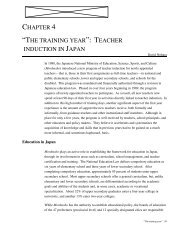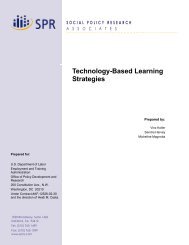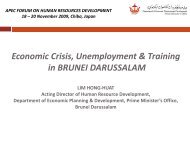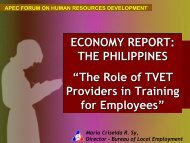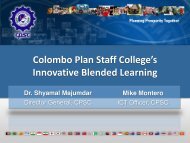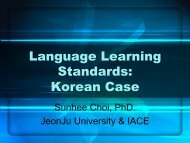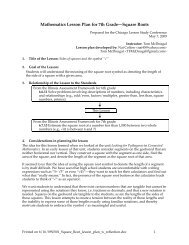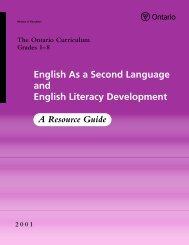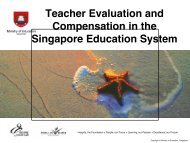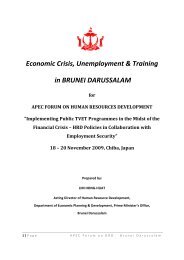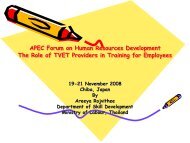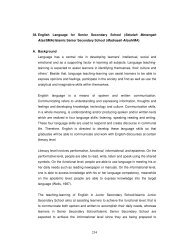Quality Assurance Systems in Asia-Pacific Economic Cooperation
Quality Assurance Systems in Asia-Pacific Economic Cooperation
Quality Assurance Systems in Asia-Pacific Economic Cooperation
You also want an ePaper? Increase the reach of your titles
YUMPU automatically turns print PDFs into web optimized ePapers that Google loves.
ENHANCEMENT OF QUALITY ASSURANCE SYSTEMS IN HIGHER EDUCATION IN APEC MEMBER ECONOMIES<br />
10. National and International <strong>Cooperation</strong><br />
10.1 UNESCO-OECD Guidel<strong>in</strong>es for <strong>Quality</strong> <strong>Assurance</strong> of<br />
CBHE<br />
Most QA systems have <strong>in</strong>dicated that they have considered the UNESCO-OECD guidel<strong>in</strong>es<br />
and the implementation is at various levels of achievement. The UNESCO-OECD guidel<strong>in</strong>es<br />
address six different stakeholders. The guidel<strong>in</strong>es addressed to the quality assurance<br />
agencies recognises the diversity found <strong>in</strong> the various aspects of quality assurance among<br />
the national systems and calls for a coord<strong>in</strong>ated effort at regional and/or global level, <strong>in</strong> order<br />
to tackle the challenges raised by the growth <strong>in</strong> new forms of cross-border delivery of higher<br />
education. In general, QA agencies have <strong>in</strong>dicated that they found the guidel<strong>in</strong>es useful.<br />
The key recommendations of the guidel<strong>in</strong>es are about <strong>in</strong>clud<strong>in</strong>g foreign and for-profit<br />
<strong>in</strong>stitutions/providers as well as other non-traditional modes of educational delivery <strong>in</strong> the<br />
scope of quality assurance, strengthen<strong>in</strong>g the network <strong>in</strong>itiatives for the quality assurance<br />
agencies to discuss cross-border education issues, <strong>in</strong>formation dissem<strong>in</strong>ation on the quality<br />
assurance mechanism and its implications, adherence to ‘Code of Good Practice’, mutual<br />
recognition agreements with other agencies, and mak<strong>in</strong>g the assessment procedures open to<br />
<strong>in</strong>ternational peers. As the discussion so far <strong>in</strong>dicates these are the areas where a lot of<br />
changes and mew practices are emerg<strong>in</strong>g <strong>in</strong> the APEC region.<br />
Networks of QA bodies such as INQAAHE and APQN have promoted discussions on<br />
UNESCO-OECD guidel<strong>in</strong>es among their member agencies. To help governments put<br />
systems <strong>in</strong> place <strong>in</strong>-l<strong>in</strong>e with the guidel<strong>in</strong>es, UNESCO-Bangkok and APQN have jo<strong>in</strong>tly<br />
developed a Tool Kit and that has resulted <strong>in</strong> awareness build<strong>in</strong>g among the QA bodies of the<br />
region.<br />
Some QA bodies have stated that they already fall <strong>in</strong> l<strong>in</strong>e with the UNESCO-OECD guidel<strong>in</strong>es<br />
and a few more are <strong>in</strong>itiat<strong>in</strong>g actions and projects to build on the guidel<strong>in</strong>es. In the com<strong>in</strong>g<br />
year NZQA will lead a coord<strong>in</strong>ated approach among government agencies, quality assurance<br />
bodies and other key stakeholder groups <strong>in</strong> a project 'Improv<strong>in</strong>g the <strong>Quality</strong> Framework for<br />
Off-shore Cross-border Education' which will <strong>in</strong>clude most of the guidel<strong>in</strong>es. The<br />
Transnational <strong>Quality</strong> Strategy of Australia gives due recognition to the UNESO-OECD<br />
guidel<strong>in</strong>es and the national quality assurance agency of Australia states that its QA practices<br />
are already <strong>in</strong> accordance to the UNESCO-OECD guidel<strong>in</strong>es.<br />
There are also a few responses that <strong>in</strong>dicate that either the agencies are yet to become<br />
familiar with the guidel<strong>in</strong>es or of the op<strong>in</strong>ion that the guidel<strong>in</strong>es are too general to be of any<br />
use to them.<br />
This is still a develop<strong>in</strong>g area and a lot of discussions are go<strong>in</strong>g on.<br />
10.2 <strong>Cooperation</strong><br />
There are only a few examples of cooperation between economies and they are <strong>in</strong> the form of<br />
Memoranda of Understand<strong>in</strong>g. For example, the New Zealand government has a<br />
memorandum of understand<strong>in</strong>g with the Malaysian government, whereby any local<br />
qualifications delivered <strong>in</strong> Malaysia must meet Malaysian as well as NZ quality assurance<br />
standards. The government of Australia has agreements with Malaysia, Thailand, New<br />
Zealand and Japan.<br />
AUQA has memoranda of cooperation (MoC) with a number of other QA agencies of the<br />
region. In each case the general purpose is for further mutual understand<strong>in</strong>g and trust, but<br />
each also has one or more specific purposes. As mentioned above, the focus of the MoC with<br />
NZUAAU is the contribution of New Zealand good practices to AUQA’s Good Practice<br />
Database. With the HKCAA, the objective is shar<strong>in</strong>g <strong>in</strong>formation about Australian <strong>in</strong>stitutions<br />
operat<strong>in</strong>g <strong>in</strong> Hong Kong. Discussions are under way with the MQA on a MoC that would<br />
emphasise jo<strong>in</strong>t audits of Australian campuses <strong>in</strong> Malaysia; and with the Shanghai Education<br />
37



